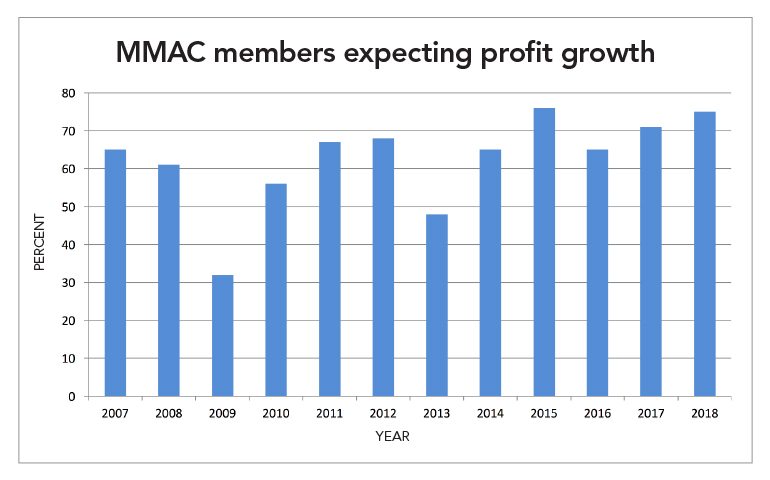Continued optimism was expressed by Milwaukee-area businesses for 2018, according to the Business Outlook Survey conducted by the Metropolitan Milwaukee Association of Commerce. Eighty percent of businesses surveyed see sales increases in 2018, 75 percent predict profit gains and 69 percent expect employment growth for their local operations.
Those numbers suggest MMAC members are more optimistic than they were a year ago. Last year, 73 percent of MMAC members predicted sales increases, 71 percent predicted profit gains and 61 percent predicted employment growth for 2017.
The percentage of MMAC members predicting profit gains in 2018 is the second-highest since the Great Recession. Since then, only the 2015 survey had a slightly higher (76 percent) percentage predicting profit gains.
The national economic expansion is now into its ninth year – one of longest on record – but it begs the question of how long it will last. While the metro area’s overall job trend was fairly sluggish in 2017, business expectations for jobs, profits and sales continue to suggest a strong local growth environment for 2018.
Sales optimism among Milwaukee-area businesses remains strong. Eighty percent of those surveyed expect increases in real sales levels in 2018. The proportion predicting 2018 sales growth ranks higher than the 73 percent that began 2017 predicting sales gains, and ranks as the strongest calendar year sales expectation expressed since 2015’s second quarter. Currently, only 6 percent predict sales declines, while the remainder (14 percent) see no change.
The sales outlook by industry is fairly balanced. Eighty-one percent of manufacturers predict sales growth in 2018, versus 79 percent among non-manufacturers. By employment size, large employers (100 or more employees) are somewhat more likely to forecast 2018 sales gains than small employers (84 percent of large employers see sales increases versus 76 percent for small companies).
Profit expectations for area businesses are likewise robust. Seventy-five percent of those surveyed see profit level improvements in 2018, four points higher than at the opening of 2017. Currently, only 8 percent see profit declines, while 18 percent expect no change. Manufacturers (79 percent) and large employers (79 percent) are most likely to predict 2018 profit gains.
Regarding capital spending plans, 53 percent forecast a rise in capital expenditures for the year. Eleven percent see capital spending declines and 37 percent expect no change. The percentage predicting increases is up from the 42 percent that opened 2017 expecting capital spending gains. About 56 percent of large employers predict increases in capital expenditures in 2018, versus 49 percent among small employers.
A lackluster metro area job trend was evident throughout 2017. Small year-over-year job declines posted in 2017’s first half were offset by small increases in its second half. Overall, on average, metro area nonfarm employment is likely to finish 2017 flat. Nonetheless, survey results suggest confidence in future job increases, with 69 percent of businesses expecting gains in their local workforces in 2018, outnumbering those predicting declines (3 percent) by a large margin. Twenty-eight percent see no change.

A majority of employers see job gains regardless of industry or size of employer. About 69 percent of manufacturers predict job increases during 2018, equaling the percentage for non-manufacturers. Seventy-one percent of small employers predict 2018 job gains (versus 67 percent for large employers).
Tighter unemployment rates may help explain an upward trend in forecast wage and salary levels. The average change in per-person employee wages and salaries is forecast to rise 3.3 percent over the next 12 months, equaling the increase projected three months ago. The current increase marks the second consecutive time and only the third time in the economic recovery period in which wage and salary expectations have matched or exceeded 3 percent.
Consumer price inflation has risen nationally in recent months from a 1.6 percent year-over-year increase in June 2017 to November’s 2.2 percent increase. Area businesses expect inflationary pressure to remain moderate. More than half (52 percent) of all companies surveyed see 2018 inflation rates falling in the 3 to 5 percent range, while the largest remaining percentage (40 percent) expect price increases of 0 to 2 percent. Eight percent foresee inflation of 6 percent or higher.
FIRST QUARTER EXPECTATIONS
Businesses are more tempered in their optimism toward 2018’s first quarter. Sixty-nine percent of those surveyed expect first-quarter real sales gains (versus 2017’s first quarter), lower than the 80 percent that predict sales increases for 2018 as a whole. Nonetheless, only 5 percent see first-quarter sales declines, and 26 percent expect no change.
First-quarter profit expectations are particularly high. Sixty-seven percent see higher profits for the quarter (versus 2017’s first quarter), while only 7 percent predict profit declines. Twenty-six percent see no change. The percentage expecting profit increases is the highest since 2015’s second quarter.
Just more than half of all businesses surveyed predict first-quarter job gains for their local operations (versus 2017’s first quarter), while only 4 percent see job declines – the smallest number expecting declines since 2015’s first quarter.
Manufacturers expressed a higher degree of confidence toward first-quarter employment gains than non-manufacturers. Fifty-five percent of manufacturers see employment increases in the first quarter of 2018 (versus 2017’s first quarter) versus 49 percent among non-manufacturers surveyed. A similar differential was registered between larger employers (54 percent predict first-quarter job gains) and smaller employers (48 percent see such gains).
The Business Outlook Survey, conducted by the MMAC, included 112 Milwaukee-area firms, both large and small, employing more than 35,900 people.
Bret Mayborne is the economic research director for the Metropolitan Milwaukee Association of Commerce.